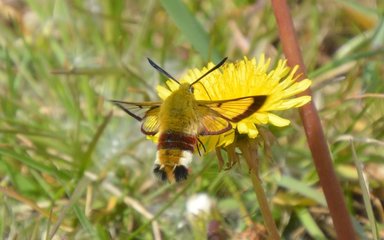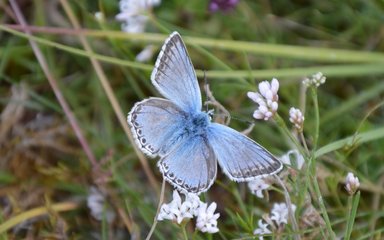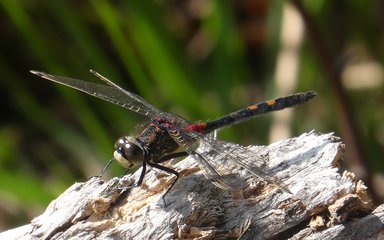
Hiding under leaf debris, tucked beneath cracked bark and flying in the tree canopy, insects exploit every nook of the nation’s forests. Deciduous woods with ancient trees harbour a particularly high diversity of insects, although conifer plantations also have many charismatic species, rarely seen elsewhere. Here’s how to spot some of Forestry England’s most fascinating creatures.
Broad-bordered bee hawk moth
This large day-flying moth species resembles a large bumblebee and is found in open woodland and clearings in early summer. Though scarce across Southern England it has a stronghold in Breckland in Suffolk and southern Norfolk.
- Where to spot it: Forestry England Thetford Forest

Minotaur beetle
These beetles provide an important nutrient-recycling service across the forest habitats as their larvae feed on dung. They can be identified by the glossy black wings, with ridges and the males have three horns along their thorax, two long horns and one short one in the centre.
- Where to spot it: The New Forest

Chalkhill blue butterfly
This beautiful butterfly is found on chalk grasslands in southern England during the summer months. The males are silvery-blue with a dark brown border on their wings and the females are brown with white fringed wings.
- Where to spot it: Forestry England Friston Forest

Pearl-bordered fritillary
This stunning orange and black butterfly can be seen in sunny woodland clearings. It gets its name from the row of 'pearls' on the underside of its hindwings.
- Where to spot it: Forestry England Abbot’s Wood

White-faced darter
The pale white face of this small dragonfly gives it its name and it has black body with the male having red-orange marking and the female yellow markings. One of the rarest dragonflies in the UK, the white-faced darter is located in shallow peaty pools.
- Where to spot it: Forestry England Delamere Forest

Black bog ant
One of the rarest ants in Britain, the black bog ant is found in only five places across the UK and as their name suggests, live in wet, boggy areas. They have a distinctive black colour and glossy abdomen.
- Where to spot it: The New Forest

Southern damselfly
This rare, beautiful damselfly favours shallow streams and water sources. With their blue, black markings these are eye-catching to spot on the wing.
- Where to spot it: The New Forest

Notes to Editor
Images available here.
- Forestry England manages and cares for the nation’s 1,500 woods and forests, with over 235 million visits per year. As England’s largest land manager, we shape landscapes and are enhancing forests for people to enjoy, wildlife to flourish and businesses to grow. For more information visit forestryengland.uk. Forestry England is an agency of the Forestry Commission.
Media Contact:
Media Office
media@forestryengland.uk
